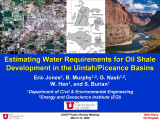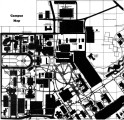TO
Filters: Collection: "ir_eua"
| Title | Date | Subject | Description | ||
|---|---|---|---|---|---|
| 1 |
 |
2012 Faculty Report | 2012 | 2012 Faculty Report; 2012 General Catalog; University of Utah catalogue; (Catalog) | The faculty report is generated by USpace through Academic Computing Services. It is provided as a companion to the Web archived version of the University of Utah catalogue;, found at http://content.lib.utah.edu/cdm/ref/collection/ir-eua/id/3085 |
| 2 |
 |
2013 Faculty Report; 2013 General Catalog | 2013 | University of Utah catalogue; (Catalog) | The faculty report is generated by USpace through Academic Computing Services. It is provided as a companion to the Web archived version of the University of Utah catalogue;, found at http://content.lib.utah.edu/cdm/ref/collection/ir-eua/id/3113 |
| 3 |
 |
Study of gas evolution during oil shale pyrolysis by TQMS | 1988-02 | gas evolution; oil shale pyrolysis; TQMS; oil shale; evolution profiles | Real-time gas evolution during pyrolysis of two Green River Formation (Colorado) oil shales, one eastern U.S. Devonian shale, and two Chinese shales was monitored using a triple quadrupole mass spectrometer (TQMS). We calculated kinetic parameters for hydrocarbon generation. For water, carbon oxides... |
| 4 |
 |
AE_Degrees and Majors | |||
| 5 |
 |
A report to Idaho National Engineering Laboratory | 1987 | Three Texas lignites (Jewett, Big Brown, and Bastrap), weathered and fresh tar sand, weathered and fresh Gilsonite and weathered oil shale have been studied using Py-MS (pyrolysis mass spectrometry) and further analyzed using the SIGMA program. | |
| 6 |
 |
Compositional and kinetic analysis of oil shale pyrolysis using TGA-MS | 2012-04 | compositional analysis; kinetic analysis; oil shale pyrolysis; TGA-MS; oil shale; western United States; oil production | There are vast resources of oil shale in the western United States. Development of technically and economically effective technologies for the conversion of oil shale to liquid fuels will help provide a long-term and secure source of transportation fuels. Developing good understanding of the decompo... |
| 7 |
 |
Comparison of methods for measuring kerogen pyrolysis rates and fitting kinetic parameters | 1987-03-23 | We determine rates of product evolution during pyrolysis of several petroleum source rocks and isolated kerogens by nonisothermal techniques, including Rock Eval pyrolysis and pyrolysis-MS/MS. The resulting data are analyzed by nonlinear regression and simpler correlation techniques in terms of disc... | |
| 8 |
 |
Shale oil value enhancement research - Quarterly report: October 1 - December 31, 1993 | 1993 | Shale oil; value enhancement; molecular types of shale oil | The first year of this effort was focussed on the following broad objectives: -Analyze the molecular types present in shale oil (as a function of molecular weight distribution ); - Determine the behavior of these molecular types in liquid-liquid extraction; -Develop the analytical tools needed to sy... |
| 9 |
 |
Application of a self-adaptive detector system on a triple quadrupole ms/ms to high explosives and sulfur-containing pyrolysis gases from oil shale | 1983-12 | A totally computerized triple quadrupole MS/MS is being extended into a dynamic, self-adaptive chemical analysis system at Lawrence Livermore National Laboratory. These first efforts toward Artificial Intelligence guided instrumentation (i.e. Expert Systems) involve the implementation of a self-adap... | |
| 10 |
 |
Metallopetroporphyrins as process indicators: mass spectral identification of Ni (ETIO) and Ni (DPEP) homologous series in Green River shale oil | 1994-12-05 | mass spectral identification; Green River shale oil; shale oil | Mass spectrometry (MS) of the porphyrin fraction of a demetallated shale oil from the LLNL Hot-Recycled-Solids retorting process exhibited homologous series of C25 to C33 (C28 maximum) for etio and C26 to C36 (C30 maximum) for DPEP (isocyclic) porphyrins, respectively. The sum of intensities after b... |
| 11 |
 |
An evaluation of triple quadrupole ms/ms for on-line analyses of trace sulfur compounds from oil shale processing | 1985 | In order to effectively reduce sulfur gas content from shale processing to environmentally acceptable levels, H2S, COS, S02 and CH3SH plus trace sulfur compounds must be removed. Of these, the trace sulfur compounds have not been well characterized but should be known to ppm levels In order to optim... | |
| 12 |
 |
Productivity and multi-screen displays | 2003-07-18 | Computer displays; Office productivity | A Comparison of Single Monitor, Multiple Monitor, and Multiple Monitor with Hydravision®Computer Displays over Simulated Office Tasks across Performance and Usability |
| 13 |
 |
OCT and Retinal Architecture | 2006-11-07 | Optical Coherence Tomography; Retina; Diagnosis | This presentation discusses Optical Coherence tomography, a diagnostic tool used in ophthalmology to produce a relatively high resolution image: 2 mm deep, cross-section rendition of the retina. |
| 14 |
 |
Further comparison of methods for measuring kerogen pyrolysis rates and fitting kinetic parameters | 1988-01-20 | measuring methods; kerogen pyrolysis rates; fitting kinetic parameters; kerogen pyrolysis; pyrolysis kinetics; Rock-Eval; pyrolysisMS/MS; hydrous pyrolysis; petroleum generation | We compare rates of product generation during pyrolysis of several petroleum source rocks and isolated kerogens by nonisothermal techniques, including Rock-Eval pyrolysis, condensed oil evolution, and pyrolysis MS/MS. We discuss problems related to temperature calibration in the Rock-Eval instrument... |
| 15 |
 |
Characterization of Pyrolysis Products from a Utah Green River Oil Shale by 13C NMR, GC/MS, and FTIR | 2013-10-14 | Pyrolysis; Utah; Green River; Oil Shale; GC/MS; FTIR; 33rd Oil Shale Symposium; Kerogen; Oil shale kerogen; 13C; NMR; TGA | |
| 16 |
 |
Experimental and modeling study of particulate formation in high-pressure diesel-like conditions | 2000 | particulate formation; high-pressure diesel-like conditions; diesel combustion process; tailpipe particulate emissions | The diesel combustion process has been characterized by combined measurements of flame intensity and extinction in the UV-visible range in an optically accessible divided-chamber diesel engine at different air/fuel ratios and constant engine speed, using n-heptane and commercial diesel oil as fuels.... |
| 17 |
 |
Estimating water requirements of oil shale development in the Uintah/Piceance Basins | 2008-03-12 | water requirements; oil shale development; water resources; oil sands | Collect geospatial data and information on water resources associated information related to oil sands and oil shale development -Conduct a regional analysis of water requirements for oil shale development incorporation urbanization, alternative energy development, and wastewater recycling/reuse -De... |
| 18 |
 |
Required Documentation 3.6: Completed Table #2, Student Affairs Staff Profile | The University of Utah 2006 Self-Study Required Documentation: Standards 1-4. Standard 3: Students. 3.6: Completed Table #2, Student Affairs Staff Profile | ||
| 19 |
 |
Economic potential of the P.R. Spring oil-impregnated deposit, Uinta Basin, Utah | 1984-08 | The P.R. Spring oil-impregnated sandstone (tar sand) deposit is located in the southeastern portion of the Uinta Basin, approximately 50 miles northwest of Grand Junction, Colorado. These oil impregnated sandstones are in the Eocene Green River Formation and five zones have been identified. These zo... | |
| 20 |
 |
Campus Map | |||
| 21 |
 |
000_Title Spread | |||
| 22 |
 |
Production of aviation turbine fuels from Kentucky and Utah bitumens | 1986-11-21 | aviation turbine fuels production; aviation turbine fuels; cost, yeild, characteristics, and chemical properties of aviation turbine fuels; Kentucky bitumen; Utah bitumen | This paper presents the results of the United States Air Force program to determine the costs, yields, physical characteristics and chemical properties of aviation turbine fuels, Grades JP-4 and JP-8, produced from Kentucky and Utah bitumens. The bitumens were upgraded by the Ashland Petroleum Compa... |
| 23 |
 |
Campus Map | |||
| 24 |
 |
Pyrolysis of Sunnyside (Utah) Tar Sand: Characterization of volatile compound evolution | 1988 | tar sand; pyrolysis | Sunnyside (Utah) tar sand was subjected to programmed temperature pyrolysis and the volatile products were detected by tandem on-line mass spectrometry (MS/MS) in real time analyses. A heating rate of 4°C/min from room temperature to 900°C was employed. Evolution of hydrogen, light hydrocarbons, n... |
| 25 |
 |
Characterization of macromolecular structure elements from a Green River oil shale | 2013-10-14 | Macromolecular Structure; Green River; Oil Shale; 33rd Oil Shale Symposium; Golden, Colorado; Kerogen; Shale; Green River oil shale; Bitumen | This work is based upon work supported by the Department of Energy under Award Number DENT0005015. The views and opinions expressed herein do not necessarily state or reflect thoseof the United States Government or any agency thereof. |
